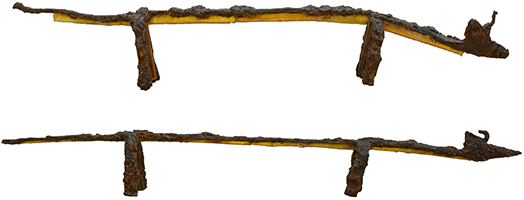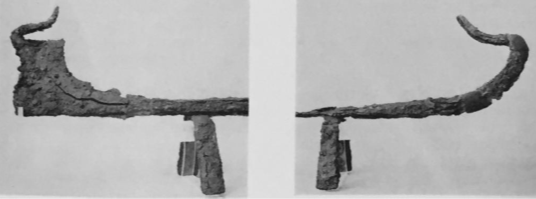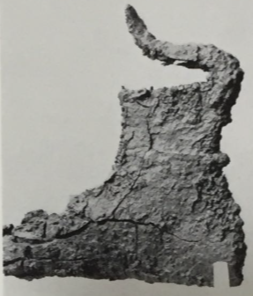The extremities of the pair of fire-dogs are
very clearly shaped as the bow and stern of a geometric galley. There
are some very obvious modifications to fit the practical function of the
objects, namely the excessively long hull and its minimalist rendition
as the keel only. The two firedogs are not identical although the
differences are minor, and they were clearly meant to go as a pair that
depicts identical ships. Both fire-dogs have at the base of the bow and
stern two protuberances which frame a cavity between them. Courbin
hypothesizes that these cavities were meant to receive a crosspiece that
joined the extremities of the two fire-dogs and kept them parallel.
These crosspieces are possibly part of the fragments but would be
difficult to tell apart from the obeloi fragments.
The bow section of the two-firedogs preserves slightly different
elements which allow for a more complete reconstruction. The bow and
forecastle consists of a single rectangular piece to which the stempost
ornament and the hull were attached. The stempost is vertical, ending in
an S-shaped horn device that curves forward then backwards parallel to
the hull. One of the fire-dogs preserves the beginning of the bow
projection. The forecastle is solid and rectangular, with two horizontal
lines in relief attached on either side that project slightly from the
stempost. These are arguably the most important detail provided, as they
are identical to the small horizontal projections observable on Attic
geometric ship depictions. The Argos models provide a definitive
confirmation that these represent wales which extended across the length
of the castles. The sternpost is simpler. It rises near vertically and
ends in an inward curving horn that resembles a stylized bird-headed
device. The shape of the ships overall is very similar to contemporary
Attic geometric depictions. The 12 obeloi which accompany the tomb's
firedogs are rectangular in section (> 110 cm in length, 1 kg average),
with a handle formed by a flat oval disc. The type is unknown from
Cyprus, which raises the possibility of local manufacture.
Ship-shaped iron fire-dogs
A51
c.725-700 B.C. LG II (last quarter, end of the 8th century B.C.)
Argos, tomb 45 (southern sector)
F-10: L 1.295 m; bow max. H.: 15.4 cm; stern max. H.: 16.2 cm; stands H.: 11 cm F-11: L: 1.34 m; bow max. H.: 10.2 cm; stern max. H.: 15 cm; stands H.: 11 cm
Two iron fire-dogs, each resting on two stands riveted at right angles to the ship's body
F 10-F11
Basch 1987: 188, no. 396, 397; Coldstream 2003: 125, 127, fig.47c; Courbin 1957: 370-79, figs.54-57; Göttlicher 1978: 338-39, taf. 25; Spathari 1995: 70, fig.77; Wachsmann 1998: 186, 188, fig. 8.50a; 2013: 2.52; Wedde 2002: 843-844
The tomb was discovered below fragments of a geometric krater. It is a 3 m long cist grave which remains unparalleled in terms of its richness compared to some one hundred eight century tombs in Argos. The inhumation is that of a male between 25-30 years of age. The offerings were found in a disturbed state due to later Roman activity, and the tomb was ostensibly hastily pillaged from its most precious belongings, notably artifacts of gold. There a few other burials which resemble tomb 45. A bronze helmet apparently from the same workshop was found in a grave from the Stavropoulos plot, over a kilometre to the northeast. Another burial from the Theodoropoulos plot, probably a generation older, contained a bronze helmet, two spearheads and six iron obeloi. Two additional burials contained obeloi. One of them is roughly contemporary with tomb 45 and fairly nearby, while the other is in an entirely different part of the settlement, in an area where five other graves spanning a century contained spearheads, swords and daggers. These seem to be for the most part isolated occurrences and do not provide evidence of elite cemeteries.
Wedde interprets the sternpost device on this pair of firedogs as an inward-facing bird-head (Wedde 2002: 843). This would make it in exception in the Aegean corpus, but would make some sense if one considers that it is otherwise an element strictly associated with Cyprus, from where the tradition of these firedogs most plausibly comes.
Basch, L. 1987. Le musée imaginaire de la marine antique. Athens: Institut Hellénique pour la preservation de la tradition nautique.
Coldstream, J.N. 2003. Geometric Greece: 900-700 B.C. 2nd ed. London: Routledge.
Courbin, P. 1957. “Une tombe géométrique d’Argos,” BCH 81: 322-386.
Göttlicher, A. 1978. Materialien für ein Korpus der Schiffsmodelle im Altertum. Mainz: Philipp von Zabern.
Spathari, E. 1995. Sailing through Time: The Ship in Greek Art. Athens: Kapon Editions.
Wachsmann, S. 1998. Seagoing Ships & Seamanship in the Bronze Age Levant. College Station, TX: Texas A&M University Press.
―――. 2013. The Gurob Ship–Cart Model and Its Mediterranean Context. College Station: Texas A&M University Press.
Wedde, M. 2002. “Birdshead Revisited: The Bow Morphology of the Early Greek Galley,” in H. Tzalas (ed.) Tropis VII: Seventh International Symposium on Ship Construction in Antiquity, Pylos, 26, 27, 28, 29 August 1999. Athens: Hellenic Institute for the Preservation of Nautical Tradition, pp. 837-56.











